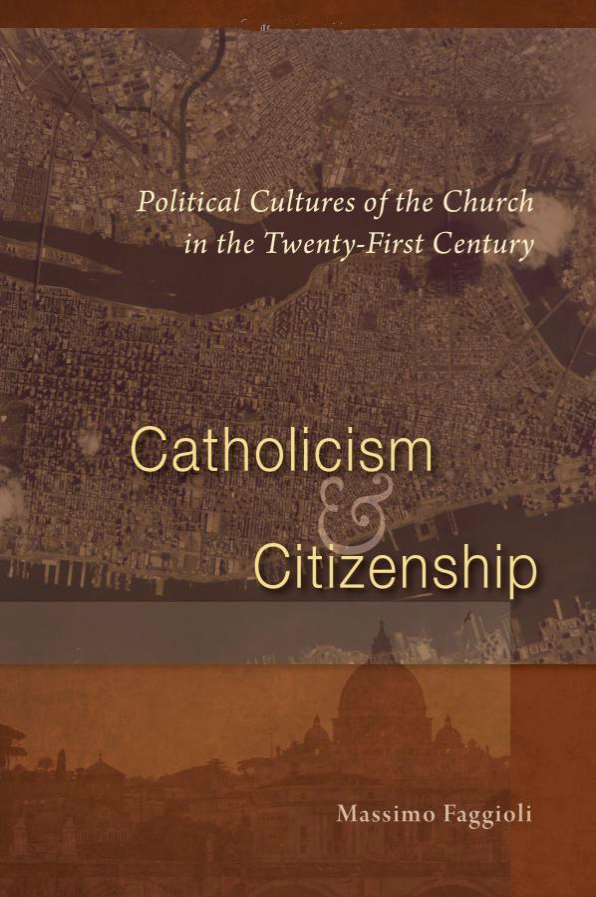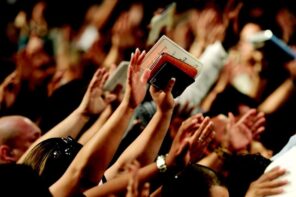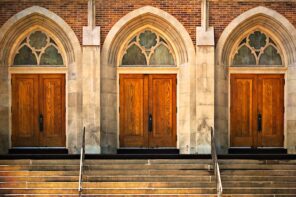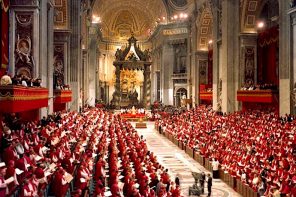Massimo Faggioli’s new book, Catholicism and Citizenship: Political Cultures of the Church in the Twenty-First Century, is based on a series of lectures and essays the Villanova professor began publishing and delivering during the 50th anniversary of Vatican II in 2015. According to Faggioli, while Vatican II has left a massive imprint on American Catholicism, its legacy as “an integral part of our political and social history” has been lost in the “political crisis” of the American church. Faggioli immigrated to America from Italy in 2007, and, he says, “this is the most American” of his books.
A rigorously scholarly book that’s nonetheless accessible to non-academics, Faggioli’s book examines the impact of Vatican II both on clergy and lay people. Faggioli says that many American Catholics “share part of the responsibility” for the “democratic crisis” in Catholicism, “because they have forgotten and neglected an important part of the Vatican II message.” His new book, and his additional role as a public theologian writing for Commonweal, La Croix International, and speaking both across the U.S. and abroad, is an attempt to reclaim and reframe that message.

Catholicism and Citizenship: Political Cultures of the Church in the Twenty-First Century
Massimo Faggioli
Liturgical Press
March 2017
We spoke in April about the dangers of clericalism, the Benedict Option, the lack of study of Vatican II in America, the Times op-ed page, and the role of theologians in the public conversation about religion.
Kaya Oakes: Your book returns often to the notion of clericalism as a problem for both lay Catholics and clergy. Could you talk about why it’s such a problem?
Massimo Faggioli: It’s a problem for many reasons. One problem is that after the ’60s, after Vatican II, there was an attempt to revitalize the importance of the clergy with an emphasis on the common priesthood of all baptized. And we thought the problem [of clericalism] had been in a certain way solved. If you speak of wearing a cassock and that symbolism, it became less important. What we’ve seen in the last 15 years is the resurgence of clericalism in a much more serious way, because we’ve gone back not just to the ’60s but before the premodern era. What’s popular in seminaries is that being a priest makes you “ontologically different” from a non-ordained person. This is a very serious and dangerous term, because part of the church before Francis is the temptation to isolate institutions, roles, and functions that are essentially historical. Jesus never instituted any priesthood.
That temptation to isolate those roles from any attempt to change them is dangerous because it’s an attempt to shield the institutions from changes that have already happened. They are trying to close the barn door when all the animals are gone. That is something new: not even an argument to go back to the past, but a philosophical ecclesiology on steroids.
That’s even more striking because the most serious emergency in the church is the seminaries and the formation of priests. We hear about bishops and priests when they screw up, but hear little about seminaries. I’m afraid there’s something going on there that’s very alarming because [seminaries] have changed little with Francis. So clericalism is part of the emergency today and has consequences for priests, lay Catholics and non-Catholics.
Part of this is the red line going through the whole book that one of the most serious temptations of the church today is to see itself as a separate planet. We have become accustomed to this with the Benedict Option, but that’s just one example. The clerical disease is at the heart of this temptation to recreate a world with the clergy in charge of everything. That is clearly a world that the vast majority of Catholics don’t live in. It could be the most serious backlash when Francis’ pontificate is over.
Why has there been so little discussion and study of Vatican II in the U.S.A.?
Backlash culture is part of this. One of the most striking things when I started my American journey was that those theologians on the progressive or centrist side were taking Vatican II for granted and looking forward without keeping an eye on the importance of preserving that. On the opposite side, those who wanted to destroy the legacy of the counsel were very active.
Handbooks for lay Catholics were critical of Vatican II in two versions. The benign version is Vatican II was good but post Vatican II was bad. But there’s an equal voice that says Vatican II was really misguided and naïve and too liberal. That is something that’s really part of the clerical culture in the U.S.A. [The bishops] said the Catholic church has to be rebuilt because of what happened after Vatican II. That’s part of the clerical culture that felt threatened by the more horizontal and secular culture in which the Catholic church realized it had to operate.
But there’s also the responsibility of Catholic academia, which took Vatican II for granted. And that is one of the typical elements of American Catholic theology. There’s either those who work between Augustine and Aquinas or those who work with the postmodern. Vatican II was in the middle no man’s land between conservative traditionalists and the other postmodern side. You can see the consequences of that in the bishops fighting for religious liberty against Obama, and they can do that only with a legal constitutional argument, but they make no reference to the teaching on religious liberty that began at Vatican II.
You mention that it’s important for the church to recognize its disagreements, but you also acknowledge the blogs, magazines and retrograde movements that disagree with Vatican II and Francis are a real problem. What can lay Catholics do to bridge this divide?
I can say what we should not do. What I think should be avoided is to look for a religious community in terms of a parish that looks like you. This is something that happens worldwide, but especially in the U.S.A. We tend to live close to people who look like us, the same ethnicity, income level. The ultimate version is the Benedict Option and all these options that try to create a Catholic community that’s homogenous and aligned on all possible issues. There are practical choices to make for example in terms of where you worship. Being Catholic in the U.S.A. was made possible by cars and parking lots.
I would say worship with people that are not exactly like you if you can. And stay faithful to your local community as long as possible. The second thing is to try to read things that will have a life that is longer than 24 hours. Don’t just pay attention to what this bishop has said or done. Not just because it’s depressing, but because it creates a separationist mentality.
The Catholic church lives or dies because of ideas and practices that have a very long horizon in mind. On every single issue, for example on LGBT issues or religious liberty, the most important contributions are not necessarily the ones published a few hours after the latest incident. They may be what we have to work with, but this is a big challenge because the world of ideas in the Catholic church has become much more volatile. There are a lot of people reading the New York Times op-ed page. And that’s unfortunate, because a lot of people just read the same thing. I lament that, because most people who care about Catholic stuff read from a niche. Being able to make sense of opposing views is something we’re less used to. I include myself in this.
What is the role of a public theologian such as yourself in our increasingly secular society? At times, even writing about religion can feel like an act of translation for a secular audience. How do you handle that as a theologian?
One thing that came and hit us very strongly in the last years is the idea that religion was going to be irrelevant very soon. This is not true, of course. We hear a lot more about religion today than in the 80s or 90s. And it’s much more subject to distortion than before. There’s more out there and it’s much more ideological in the way it’s used. What I try to do is the negative work, negative in the sense of cautioning people from the idea that this or that church event can be easily used by a particular agenda. But that is not the most urgent thing. To caution against the enthusiasm of the fans of some religious leader or the hatred of the opponents of that is.
It is one part religious translation. What I’ve been doing is to translate not so much for the general public, but to translate things that are by non-Americans for American scholars and a public that’s not the same public as New York Times readers. This is something that struck and surprised me: how much translation there is in each of the sub-theological worlds of North America. Knowing and being able to read in one language says nothing of the real access to the idea of coming from that linguistic world.
We know that there are almost half or more Catholics [who] are Spanish-speaking. But there’s little exchange between North American theologians and Latin American theologians. European theologians know little about what’s going on in America. This is more urgent right now because you can’t understand Catholicism from one observation point only. If you want to say something about Catholicism, it’s worthless to speak only from your national position. It’s subject to idiosyncrasies.





